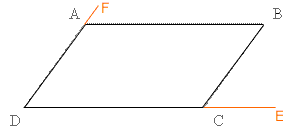Hi! My name is Hanna and I am having difficulty on my geometric proofs. I am in the 9th grade and am a student.
Here is one problem I don’t understand.
Given: ABCD is a quadrilateral; <A is congruent to <C; <B is congruent to <D
Prove: ABCD is a parallelogram
Hi Hanna,
Different books might define a parallelogram differently but I am going to assume that your book defines a parallelogram as "a quadrilateral with both pairs of opposite sides parallel". I am also not sure what facts you know but let me try a proof.
I have reproduced your diagram below with two additional constructed line segments. Extend the line segment DC to a point E and extend the line segment DA to a point F.

I can conclude that the sides AB abd CD are parallel if I can show that <CBA and <ECB are congruent. You know that the measure of the four interior angles of a quadrilateral add to 360 degrees, thus
measure(<A) + measure(<B) + measure(<C) + measure(<D) = 360 degrees
But angles A and C are congruent and angles D and B are congruent. Hence
measure(<C) + measure(<B) + measure(<A) + measure(<B) = 360 degrees
so
measure(<C) + measure(<B) = 180 degrees ---- equation 1
Also DCE is a straight line so measure(<BCD) + measure(<BCE) = 180 degrees. That is
measure(<C) + measure(<BCE) = 180 degrees ---- equation 2
Hence from equations 1 and 2
measure(<B) = measure(<BCE)
that is
measure(<CBA) = measure(<BCE)
Hence the sides AB and CD are parallel.
Now use the extension of the line segment DA to F to show that the sides AD and CB are parallel.
Penny